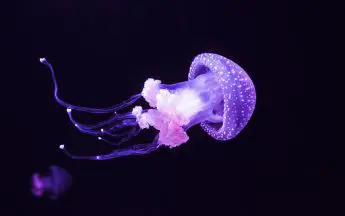Introduction
Quick Navigation
One of the many marine animals of interest is the Jellyfish. It sparks people’s interest because of its small size but a huge role in maintaining a stable ecosystem. Some large marine creatures depend on it as a food source.
People often ask: “what is a jellyfish’s diet if other creatures depend on it?” The truth, however, is: Jellyfish eat anything small and living that can fit into the mouth. It is quite surprising the kind of diet they choose to go for, but understanding the structural makeup of these jellyfish will be of help.
About Jellyfish
Jellyfish are one of the many popular marine animals that contribute to the water ecosystem. They are found in all oceans of the world but come in different species. However, they have gelatinous, bell-shaped bodies with no blood, brains, hearts, or organs.
Jellyfish find a way to survive underwater with their tentacles. These tentacles release stingers into the bodies of their victims, causing mild to excruciating pain, depending on the size and species of the fish.
This fish has different life stages – from the egg to ephyrae, and finally the adult stage (medusae). There are scenarios where some of their stages are not easily recognized as jellyfish.
What Do Jellyfish Eat?
Jellyfish can be categorized into two feeding groups, depending on their diet – Carnivores and Opportunistic Predators. As carnivores, they are known to be meat-loving; on the other hand, they eat anything they come across as opportunistic predators. In some cases, you will find Jellyfish as cannibals.
Nevertheless, most Jellyfish have been seen to love zooplanktons since their size can easily fit into the fish’s mouth. Also, they love eggs from crustaceans and brine shrimp.
How Do These Fish Get Food?
If Jellyfish love meat or anything that comes their way, then there is a way they go about finding their food. Unfortunately, they aren’t good swimmers, justifying why they are opportunistic predators. However, they can propel themselves or drift along with ocean currents until they trap their prey with tentacles.
These tentacles, as mentioned earlier above, contain stinging cells called Cnidocytes with venom-packed stingers called Nematocysts. So, whenever they trap their prey, they inject the venom, making them paralyzed. In some situations, the venom can kill their prey depending on the species of Jellyfish. Once their prey is vulnerable, they pull the food into their mouth with their oral arms. These arms guide the food through the hole at the bottom center of the jellyfish body. This same hole is where egestion takes place.
With the prey pulled into the mouth, assisted by the arms, it goes down to the gastrovascular activity where digestion takes place. They are translucent animals, which makes it easy to see what happens within them.
Is an Adult Jellyfish Diet Different from the Baby’s (Ephyrae)?
Knowing the feeding sequence of Jellyfish is one thing; however, it is important to discuss the normal diet for both adult and baby fish. Ephyrae, also called Baby Jellyfish, has a different diet from Medusae, also called Adult Jellyfish.
Following the lifecycle from hatched eggs to planula larva and then to Ephyrae, feeding starts. The baby jellyfish only feeds on smaller food particles or the eggs or larvae of other animals at this stage. Sometimes, they can be fed with brine shrimp eggs or hatched brine shrimp. They don’t have a large intake due to their size.
After an Ephryae is adequately fed, it starts to grow until it becomes Medusae. The formation of round bell-shaped body is a sign of full formation.
At the Medusae stage, Jellyfish can start to feed on larger food particles that can fit into their mouths. Zooplanktons are their favorite, followed by brine shrimp. However, they are not scavengers but could rather opt-in for frozen foods. They feed on this diet until death.
What are the Food Options Available to Jellyfish?
With the discussion on the various diets for Adult and Baby Jellyfish above, it is essential to list the several food options available to them underwater. Here goes a comprehensive list of options.
Brine Shrimp
Larvae
Eggs
Mollusks
Sea Snails
Smaller fish
How to Maintain a Normal Diet for Jellyfish Pet?
What if you keep Jellyfish as pets? How do you feed them? Maintaining a normal diet for your Jellyfish is important because their survival depends on it.
Ideally, they need to be fed at least once every day, depending on their quantity and size. You can decide to administer their feed in different ways; however, the most effective is using a pipette. Likewise, you could use a small baster.
Place the pipette or small baster containing food (brine shrimp or zooplanktons) into the Jellyfish tank and empty the content. If you have a group of Jellyfish (Smack), ensure to deliver large quantities because some species of Jellyfish feed more than others.
What To Be Aware Of?
Keeping Jellyfish as pets is great because they are lovely sights to see; however, you need to be careful. Jellyfish may pose the same risk as they do in oceans to the tank, i.e., the release of venoms to their prey or anything they come in contact with.
So, if you are taking care of Jellyfish, you should try not to get attacked by them. If peradventure you do, ensure to treat the wound immediately with vinegar or saltwater. More importantly, it would be best if you never peed on the affected area or remove the tentacles with your hands, except with tweezers.
See here on how to treat basic marine life injuries.
Conclusion
Exploring the life of Jellyfish is an interesting one because you now know more about them than just being stinging animals. Jellyfish are beautiful creatures with a simple feeding habit, regardless of the stage in their lifecycle. If you ever keep one or a group of Jellyfish as pets, you need to be careful about how you handle them when feeding them.

